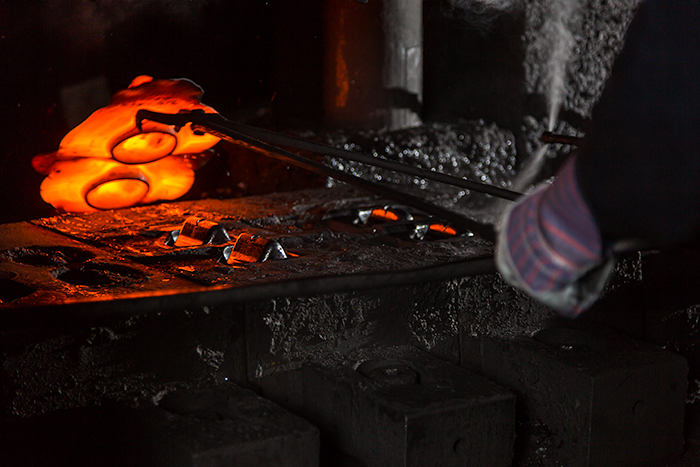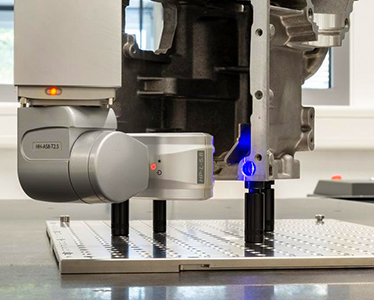Forging process introduction
2023-07-14
Forging is the use of forging machinery to exert pressure on the metal blank to produce plastic deformation, in order to obtain a certain mechanical properties, a certain shape and size of the forging processing method. Forging and stamping are both plastic processing properties, collectively known as forging.
Forging is a common forming method in Maple.
Through forging can eliminate the metal as cast loose, welded holes, the mechanical properties of the forging is generally better than the same material castings. For important parts with high load and severe working conditions in machinery, forgings are mostly used in addition to the simple plates, profiles or welding parts that can be rolled.
Forging can be divided into cold forging and hot forging according to the temperature of the blank during processing. Cold forging is generally processed at room temperature, while hot forging is processed at a higher recrystallization temperature than the blank metal. Sometimes also in a heated state, but the temperature does not exceed the recrystallization temperature forging is called warm forging. However, this division is not completely uniform in production.
The recrystallization temperature of steel is about 460℃, but 800℃ is generally used as the division line, higher than 800℃ is hot forging; Between 300 and 800 ° C is called warm forging or semi-hot forging.
Forging according to the forming method can be divided into free forging, die forging, cold heading, radial forging, extrusion, forming rolling, roll forging, rolling and so on. The deformation of the blank under pressure is basically free forging, also known as open forging; The billet deformation of other forging methods is limited by the mold, which is called closed mode forging. There is a relative rotation movement between the forming tools of forming rolling, roll forging, rolling, etc., and the blank is pressed and formed point by point and asymptotically, so it is also called rotary forging.
Forging materials are mainly carbon steel and alloy steel of various components, followed by aluminum, magnesium, copper, titanium and their alloys. The original state of the material is bar, ingot, metal powder and liquid metal.
Generally, small and medium-sized forgings use round or square bar material as blank. The grain structure and mechanical properties of the bar are uniform and good, the shape and size are accurate, the surface quality is good, and it is easy to organize mass production. As long as the heating temperature and deformation conditions are reasonably controlled, no large forging deformation is required to forge good forgings.
Ingot is only used for large forgings. The ingot is a cast structure with a large columnar crystal and loose center. Therefore, the columnar crystal must be broken into fine grains through large plastic deformation and loose compaction in order to obtain excellent metal structure and mechanical properties.
Powder forgings can be made by pressing and firing powder metallurgy preforms under hot conditions by die forging without flash edges. The forging powder is close to the density of general die forging parts, has good mechanical properties, and high precision, which can reduce the subsequent cutting process. Powder forgings have uniform internal organization and no segregation, and can be used to manufacture small gears and other workpieces. However, the price of powder is much higher than that of general bars, and its application in production is subject to certain restrictions.
By applying static pressure to the liquid metal cast in the die, it can solidify, crystallize, flow, plastic deformation and form under the action of pressure, and the desired shape and performance of the die forging can be obtained. Liquid metal die forging is a forming method between die casting and die forging, which is especially suitable for complex thin-walled parts that are difficult to form in general die forging.
Different forging methods have different processes, in which the hot die forging process is the longest, the general order is: forging blank blanking; Forging billet heating; Roll forging preparation; Die forging forming; Trim; Intermediate inspection, inspection of forging size and surface defects; Heat treatment of forgings to eliminate forging stress and improve metal cutting performance; Cleaning, mainly to remove the surface oxide; Rectify; Inspection, general forgings to go through the appearance and hardness inspection, important forgings also through chemical composition analysis, mechanical properties, residual stress and other tests and non-destructive testing.
Forging is a combination of forging and stamping, is the use of forging machinery hammer, anvil block, punch or through the die to exert pressure on the blank, so as to produce plastic deformation, so as to obtain the required shape and size of the workpiece forming processing method.
During the forging process, the billet as a whole has obvious plastic deformation and a large amount of plastic flow. In the stamping process, the billet is formed mainly by changing the spatial position of the area of each part, and there is no large distance plastic flow inside. Forging is mainly used for processing metal parts, and can also be used for processing some non-metals, such as engineering plastics, rubber, ceramic billet, brick and composite material forming.
Rolling and drawing in the forging and metallurgical industry are plastic processing, or pressure processing, but forging is mainly used for the production of metal parts, while rolling and drawing are mainly used for the production of sheet metal, strip, pipe, profile and wire and other universal metal materials.
By the end of the Neolithic Age, humans had begun hammering natural red copper to make ornaments and gadgets. Cold forging process has been used in China about 2000 BC to make tools, such as the red copper objects unearthed at the Taiqijia cultural site of Empress Niniang in Wuwei, Gansu Province, there are obvious traces of hammering. In the middle of the Shang Dynasty, meteorite iron was used to make weapons by heating forging process. The block wrought iron that appeared in the late spring and Autumn period was forged by repeated heating to extrude oxide inclusions and formed.
At first, people used hammer swing to forge, and later appeared to use people pulling ropes and tackles to lift the heavy hammer and then freely drop the method of forging blanks. After the 14th century, animal and hydraulic drop hammer forging appeared.
In 1842, the British Nesmith made the first steam hammer, so that forging into the era of application of power. Later came forging hydraulic press, motor driven cleat hammer, air forging hammer and mechanical press. The splint hammer was first used during the American Civil War (1861 ~ 1865) to forge parts of weapons, and then the steam die forging hammer appeared in Europe, and the die forging process was gradually promoted. By the end of the 19th century has formed the basic categories of modern forging machinery.
In the early 20th century, with the mass production of automobiles, hot die forging developed rapidly and became the main forging process. In the middle of the 20th century, hot die forging presses, flat forging machines and anvil-less forging hammers gradually replaced ordinary forging hammers, improving productivity and reducing vibration and noise. With the development of new forging processes such as forging billet less and no oxidation heating technology, high precision and long life mold, hot extrusion, forming rolling and forging operators, manipulators and automatic forging production lines, the efficiency and economic effect of forging production have been continuously improved.
























































